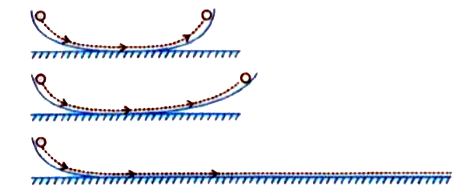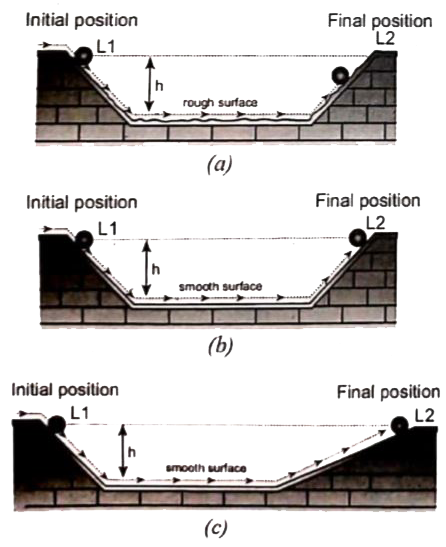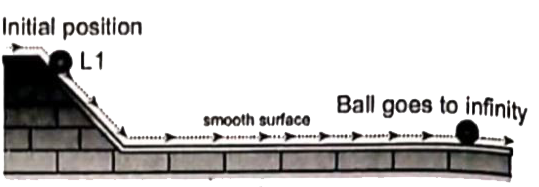Describe Galileo’s experiment of inclined plane regarding motion.Solution in Gujrati
To study motion of object inclined plane Galileo performed two experiment.
First Experiment.

As shown in figure he aranged two l plane at same inclination and allowed spherical object to move along incline following were his observation
(i) A sphere moving down a incline has increase.
(ii) For sphere moving upward on incline has intermediate condition from this galileo acceleration or retardation . He concluded that body will continue motion with constant velocity.
Second Experiment
As shown in figure two plane with some slope are considered

When a body is allowed from rest to move on the slopw its velocity increase and on opposite slope its velocity decreases.
In ideal condition when there is the no friction height .
When slope of second plane is kept first slope to attain similar height ball to cover more distance.
In practise continous motion of ball is not possible but after covering some distance ball force which cannot be totally eliminated .
Topper's Solved these Questions
- BOOK - KUMAR PRAKASHANCHAPTER - LAW OF MOTIONEXERCISE - SECTION -B (NUMERICAL FROM TEXTUAL ILLUSTRATION)12videos
LAW OF MOTION
- BOOK - KUMAR PRAKASHANCHAPTER - LAW OF MOTIONEXERCISE - SECTION -B (NUMERICAL FROM TEXTUAL EXERCISE)23videos
LAW OF MOTION
- BOOK - KUMAR PRAKASHANCHAPTER - LAW OF MOTIONEXERCISE - (QUESTION PAPER) SECTION-D1videos
LAW OF MOTION
- BOOK - KUMAR PRAKASHANCHAPTER - GRAVITATIONEXERCISE - QUESTIONS PAPER Section - D1videos
GRAVITATION
- BOOK - KUMAR PRAKASHANCHAPTER - MACHANICAL PROPERTIES OF SOLIDS EXERCISE - QUESTION PAPER11videos
MACHANICAL PROPERTIES OF SOLIDS
Similar Questions
An astronaut accidentally gets separated out of his small spaceship accelerating in inter stellar space at a constant rate of 100ms−2 . What is the acceleration of the astronaut the instant after he is outside the spaceship ? (Assume that there are no nearby stars to exert gravitational force on him.)
07:14View SolutionGive the magnitude and direction of the net force acting on (a) a drop of rain falling down with a constant speed, (b) a cork of mass 10 g floating on water, (c) a kite skillfully held stationary in the sky, (d) a car moving with a constant velocity of 30 km/h on a rough road, (e) a high-speed electron in space far from all material objects, and free of electric and magnetic fields.
08:39View SolutionA 70 kg man stands in contact against the inner wall of a hollow cylindrical drum of radius 3 m rotating about its vertical axis with 200 rev/min. The coefficient of friction between the wall and his clothing is 0.15. What is the minimum rotational speed of the cylinder to enable the man to remain stuck to the wall (without falling) when the floor is suddenly removed ?
15:15View SolutionA spaceship is stationed on Mars. How much energy must be expended on the spaceship to launch it out of the solar system ? Mass of the spaceship = 1000 kg, mass of the sun =2×1030kg, mass of mars =6.4×1023kg, radius of mars = 3395 km, radius of the orbit of mars =2.28×108km,G=6.67×10−11Nm2kg2
38:28View SolutionWhat is called brittle material ?
05:00View SolutionMotion Upon Inclined Plane
41:28View SolutionMotion Of A Body On An Inclined Plane
44:53View SolutionProjectile Motion - On An Inclined Plane
03:40View SolutionPROJECTILE MOTION ON AN INCLINED PLANE
36:53View SolutionDescribe galileo experiments concerning motion of object on inclined planes


galileo 's experiment with the second plane (a) at same inclination angle as the first (b) with increased smoothness (c ) with reduced angle of inclination (d) with zero angle of inclination32:29View SolutionMOTION OF A BODY ON INCLINED PLANE
01:16:16View SolutionRolling motion on Inclined Plane
51:31View SolutionDescribe Galileo's experiments concerning motionof objects on inclined planes. Hence state the law of inertia.
35:16View SolutionProjectile MOtion On Inclined Plane
49:41View SolutionProjectile motion on Inclined Plane|NEET Important Questions
01:04:08View Solution

